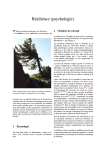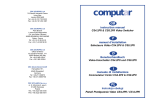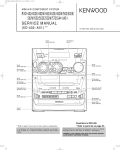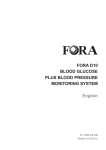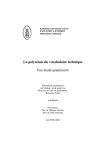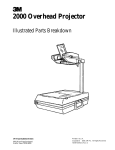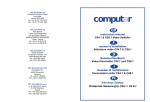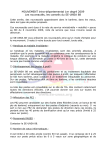Download 1 Introduction 2 Background
Transcript
1
1 Introduction
The purpose of this work is to produce a part-of-speech tagger for French using morphological
analysis provided by a nite-state transducer. The tagger also utilizes a combination of statistical
learning and linguistic knowledge and is built in a pipelined architecture. All modules, except for
preprocessing and morphological analysis, can be ordered in various ways. Part of speech tagging
consists of applying several disambiguation modules on a list of ambiguous words until a single tag
remains for each word. We propose and evaluate a sequencing strategy for the various modules and
point out the best sequencing available. Several experiments were performed to gure out the best
order of the dierent modules. Results showed that optimal results are obtained when morphological
analysis is applied rst, followed, in that order, by the application of linguistic constraints, the
statistical stage, and, nally, the mapping of the large tagset to a smaller one.
2 Background
French is an inherently ambiguous language when it comes to morphological analysis. For example,
the word \mise" can have as many as eight morphological analyses.
``mise''
``mise''
``mise''
``mise''
``mise''
``mise''
``mise''
``mise''
-
<mis>
<mis>
<miser>
<miser>
<miser>
<miser>
<miser>
<miser>
adjective, feminine singular
noun, feminine singular
past participle, feminine singular
verb, 1st person, singular, present,
verb, 1st person, singular, present,
verb, 2nd person, singular, present,
verb, 3rd person, singular, present,
verb, 3rd person, singular, present,
indicative
subjunctive
imperative
indicative
subjunctive
The goal of a part-of-speech tagger is to reduce the number of part-of-speech ambiguities; this
is achieved by using a combination of linguistic knowledge and statistical rules that progressively
reduce the number of possible tags for a given word. A tag contains information about the part of
speech, as well as about certain grammatical categories such as tense, mood, number, and gender.
The input to the system is a French text, with 8-bit encoded accents. Table 1 shows an example of
text data:
L'usine, qui devrait ^etre implantee a Eloyes (Vosges)
represente un investissement d'environ 3,7 milliards de yens
(148 milliards de francs). Elle fabriquera, dans un premier temps,
le produit liquide qui entre dans le processus des photocopies ainsi
que des pieces detachees pour la liale de Minolta en RFA.
Table 1: Corpus Sample of newswire compiled by the French embassy in Washington, D.C.
The goal is to obtain an output text where a single part-of-speech is associated with each word.
Table 2 shows the output of the rst sentence of the text in Table 1 disambiguated at a word
level. In the left column are the words corresponding to the French corpus, the part-of-speech tags
corresponding to the words (\tag" le) are in the right column.
Linguistic knowledge about possible sequencing of parts of speech is very powerful, since several
types of restrictions can be expressed for words and tags in context. For example, an article cannot
be followed by a verb in French, as well as in many other languages. Given that many words have
unique tags, restriction rules could use such words as anchors to disambiguate surrounding words.
Part-of-Speech Tagger for French: a User's Manual
Word
<S>
L
usine
,
qui
devrait
^etre
implante'e
a
E loyes
(
Vosges
)
represente
un
investissement
d
environ
3
,
7
milliards
de
yens
(
148
milliards
de
francs
)
<S>
p.o.s. tag
^
RDF
NFS
.
E
V3SPC
&N
QSFS
P
U
.
U
.
V3SPI
RIMS
NMS
P
P
W
.
W
W
P
NMP
.
W
W
P
NMP
.
$
Meaning of the tag
beginning of sentence
denite feminine article
feminine singular noun
punctuation
relative pronoun
verb 3rd person singular present conditional
auxiliary innitive
past participle feminine singular
preposition
proper noun
punctuation
proper noun
punctuation
verb 3st person singular present indicative
indenite masculine singular article
masculine singular noun
preposition
preposition
numeral
punctuation
numeral
numeral
preposition
masculine plural noun
punctuation
numeral
numeral
preposition
masculine plural noun
punctuation
end of sentence
Table 2: Sample output of the tagger for the rst sentence from the text in Table 1
2
Part-of-Speech Tagger for French: a User's Manual
3
On the other hand, statistical learning is used as follows: given a manually tagged training
corpus, the most frequent tags from each combination of tags can be easily learned. When the
statistical knowledge is applied, the best decisions based on the disambiguated data are made.
We look at the morphological analysis, the deterministic stage, and the statistical stage as operators which modify the current tag assignment of the corpus and produce a new and more accurate
tag assignment. There are additional modules, such as preprocessing and morphological stages, that
are applied in a xed order. The whole process of tagging can be looked at as the composition
of these processing operators. Since the operators are compositional (they can be applied in any
order), we can theoretically order them in many dierent ways. We want to nd out what sequence
of operators leads to an overall improvement of the tagging accuracy.
3 Related Work
There are a number of taggers and tagging methods available; for the last decades, works in part-ofspeech tagging have generally followed either a rule-based approach ([9] , [4] , [15] ), or a statistical
one ([1] , [10] , [11] , [6] , [5] ). Statistical approaches often use Hidden Markov Models for estimating
lexical and contextual probabilities, while rule-based systems capture linguistic generalities to express
contextual rules. Most of these works have beneted from large tagged corpora, making feasible the
training and testing procedures. However, no publicly available large tagged corpora exist for French,
so other techniques had to be discovered to tackle this problem.
4 Theoretical Principles
This section contains a formal description of the tagging scheme. A list of denitions of terms used
in this work is also provided.
4.1 Denitions
The initial tag assignment is the tag assignment after preprocessing and morphology.
A tag assignment TA is a list of lexemes along with a set of tags (correct or not) assigned
at a particular stage to each of the words in the corpus. The following is an example of a TA
data structure:
L
[BD3S RDF
RDM]
usine [NFS V 1SPI V 1SPS V 2SPM V 3SPI V 3SPS]
The word to be tagged is in the left-hand column, whereas the the right-hand column lists the
tags associated with this word. The left hand side is the word and the right hand side { the
list of tags associated with this word.
The correct tag assignment TAc is a tag assignment in which each word has been assigned
one tag only - the correct one. A training corpus of 10,000 words has been manually tagged
and used as a basis for evaluating newly tagged corpora.
The tagsets TS: two tagsets have been considered - a large one consisting of 253 tags, and
a smaller one consisting of 67 tags. In addition, the user can specify any generalized subset
of tags occuring in the large tagset. The tagsets are shown in Appendix A - Section C. The
tags within each tagset have a hierarchical structure. They contain information about the
0
Part-of-Speech Tagger for French: a User's Manual
4
part of speech as well as some morphological features such as mood, tense, person, gender,
and number. Each tag is actually an acronym carrying morphological information.
Example: V refers to verbs in general, V 3S refers to third person singular verbs of any mood
or tense, V 3SPI refers to third person singular verbs in present of the indicative, and V:S
refers to all singular verbs.
This terminology has several advantages. When negative constraints are applied, they can be
invoked at several levels of the tag, using all the available combinations; in the above example,
a rule can apply to the part-of-speech (p.o.s.) only, the p.o.s. and the number, the p.o.s. and
the person, the p.o.s. and the tense, or the p.o.s. with its mood, tense, person, and number.
The accuracy function c(TAi ) refers to the accuracy of the current tag assignment TAi ,
when compared to the correct TA, i.e. (TAc ).
The inaccuracy function i(TAi ) refers to the percentage of incorrect tags in a given TAi .
The ambiguity function a(TAi ) refers to the percentage of incorrect tags in a given TAi .
If TAc has 1000 words, and 700 of them are tagged correctly in TAi , 10 of them are tagged
incorrectly, and the remaining 290 are still ambiguous at this stage, then c(TAi ) = 70.0 %,
i(TAi ) = 0.1 %, and a(TAi ) = 29.9 %.
A genotype is the list of all possible tags that a given word can inherit from the morphological
module.
Example: the word \mise" has the following genotype: [JFS NFS QSFS V1SPI V1SPS
V2SPM V3SPI V3SPS].
A statistical decision consists of a genotype, its most likely (predominant) resolution in the
training corpus, and the likelihood of that resolution.
Example: if [PNP] are possible tags, then [P] is selected in 96.85 % of the cases (768 out of
793).
Processing operators are essentially functions that take a tag assignment as argument and
produce another tag assignment. Operators are explained in more detail in the next section.
Example: If P is a processing operator, and TA1 a tag assignment, then P(TA1) = TA2,
which means that TA2 is the resulting tag assignment.
P
L
[BD3S RDF
RDM ]
usine [NFS V 1SPI V 1SPS V 2SPM V 3SPI V 3SPS ]
0
=
L
[RDF ]
usine [NFS ]
0
A tagging scheme is a composition of n processing operators, which, when applied on the
initial tag assignment (TA0 ) returns another tag assignment (TAn ). In order to keep our
notation consistent, we shall use the concatenation of the symbols, representing the operators
in composition to refer to a given tagging scheme. For example, we shall use DAT to express
that 3 operators deterministic (D), application of n-gram statistical decisions(A), and tagset
reduction (T) have been applied to the initial TA.
For simplicity, the P, M, and L stages (preprocessing, morphology, and learning - see next
section) will be omitted when referring to a particular tagging scheme. The rules are simple:
P and M are applied rst, also, there must be an L stage before the A stages.
Example: The tag scheme DA5 DT means the composition T(D(A5 (D(TA0 )))).
Part-of-Speech Tagger for French: a User's Manual
5
Negative constraints
Negative constraints are examples of deterministic knowledge that express linguistic relationships between the features of the words in a given n-gram, thereby performing some contextual
disambiguation over strings of tags. It seemed natural to use human expertise to partly disambiguate text through rules. Of course, one could argue that the machine would eventually
learn it, but generalities that capture gender and number agreement are straightforward to
state. They are available to the human without eort, they are easy to implement.
Each of the linguistic constraints is applied several times over the anchors of the corpus. This
way, anchors can create new anchors and thus enlarge the islands of disambiguated words.
Example:
{ BS3 BD1 (3rd person subject personal pronoun; 1st person indirect personal pronoun).
In the phrase \il nous faut" (\we need", literally \it is necessary to us") { the tags are
BS3MS for \il" and (BD1P BI1P BJ1P BR1P BS1P) for \nous". The negative constraint
\BS3 BD1" rules out \BD1P" and thus reduces the alternatives from 5 to 4 for the word
\nous".
{ N K (noun; interrogative pronoun). In the phrase \... euve qui ..." (...river, that...),
\qui" can be tagged both as an \E" (relative pronoun) and a \K" (interrogative pronoun);
the \E" will be chosen by the tagger since \K" cannot follow a noun (\N").
{ R V (article; verb): for example \l'appelle" (call him/her). The word \appelle" can only
be a verb, but \l"' can be either an article or a personal pronoun. Thus, the rule will
eliminate the article tag, giving preference to the pronoun.
4.2 Formulation of the tagging problem
An initial tag assignment is given on which a tagging scheme is applied through processing operators
P1P2 :::Pn. The goal is to obtain TAn (a new tag assignment) with a maximal accuracy. That is,
one wants to have a(TAn ) = max. Since there are many possible tagging schemes, one objective is
to determine which one of them is the best. This will be the \optimal tagging scheme" which will
be kept for tagging.
5 Implementation
We have developed all the software tools necessary in preprocessing and tagging the text, as well as
additional utility programs. Most of the tools are implemented in PERL and shell script.
Several software tools have been developed in PERL, with a few shell scripts, which execute the
dierent operators described above, as well as additional bookkeeping lters, utilities, and other
programs. These tools are described in detail in Appendix A. The dierent tools are used to
implement the processing operators mentioned in the previous section.
5.1 Text preprocessing
A raw corpus of text is the input to the preprocessor. Several lters need to be applied in order to
normalize the text. The following steps are applied:
Sentence boundaries: places where sentences begin and end are identied and replaced by
appropriate SGML tags. Punctuation symbols are also assigned special tags.
Part-of-Speech Tagger for French: a User's Manual
6
Proper nouns: the morphological dictionary contains common nouns and proper nouns, but
the productivity of proper nouns is very high. Therefore, each word starting a sentence needs
to be identied and recognized as either a common or a proper noun. These words undergo
special treatment: each word starting a sentence will be given the PROPER noun tag; after
morphological analysis, if the word inherits a new analysis, the latter one will prevail; if not,
the word is identied as PROPER noun and is dynamically added to the PROPER NAMES
dictionary (see Section 5.2). If an initial uppercase word is found in the middle of a sentence,
it will inherit immediately the PROPER noun tag. An additional diculty due to the accents appears. In continental French, accented characters lose their accents if they become
capitalized. This is valid in both sentence initial position and in the middle of the sentence.
Therefore, many words in the text will be missing their accents. A phonology-based recovery
technique is applied in order to attempt to recover these accents. Namely, an initial uppercase
vowel will get an accent if it precedes a consonant in the following conguration:
{ if the word starts with the following pattern ECV, where E is the character \E", C is
one of the consonants [b, bl, br, c, ch, cl, cr, d, dl, dr, f, , fr, g, gl, gr, h, j, j, l, m, n, p,
ph, pl, pr, q, r, s, sl, sr, t, tl, tr, v, vl, vr, z], and V one of the vowels [a, e, i, o, u, y], the
acute accent is recovered.
{ if the observed word is \A" or \Etre", the accent will be grave or circumex respectively
in order to produce \a" and \^etre".
Acronyms: similarly to the case for proper nouns, the an initial guess that a certain word
might be an acronym will be validated only if there are no other tags available from the
morphology lookup.
Compound words: compound words or non-compositional words in French are to be tagged
as a separate entity and not as a sequence of two or three dierent words. These are recognized
as such by looking in a dictionary of lexical compounds at this stage and considered as a single
lexical unit. For example, locutions such as \a priori", \top secret", or \raz de maree" will be
treated as unique lexical entries.
Personal pronouns: if two words are connected by a dash \-", and the second word is
a personal pronoun, the two words are considered individually. For example, the compound
\dit-elle" (said she) is analyzed as two words \dit" and \elle".
Word splitting: when all preprocessing has completed, the corpus is split into words and
translated from 8-bit characters to 7-bit ascii characters. Accents are expressed by diacritic
symbols that follow the unaccented letter. For example \^etre" is represented as \e^tre".
5.2 Morphological processing
We use nite-state transducers (FST) for the morphological analysis. Our FST is built on the
model developed for Spanish morphology [14] and handles mainly inectional morphology as well
as some derivational axes, such as \anti-" (anti) in \anti-iranien" (anti-iranien), and \arriere"
(great) in \arriere-grand-pere" (great-grandfather). The nite-state dictionary is originally built
using the Robert Encyclopedic dictionary [7] and is increased through acquisition of proper nouns
from unrestricted texts. The FST used in the morphological stage of the tagger can consist of up to
4 distinct sub-FST's:
1. main (non-proper-noun FST),
2. proper-noun FST, compiled from various sources,
3. proper-noun FST dynamically generated from the training corpus,
Part-of-Speech Tagger for French: a User's Manual
7
4. proper-noun FST generated heuristically from the current test corpus.
Nearly complete conjugations for French verbs are included in the main FST.
5.3 Tagset choice and hand tagging
We believed that a exible tagset will be of benet for the diverse applications that could make use
of the tagger. Thus we have provided a facility to translate between our original (large) tagset and
the tagset in use for a specic application. We perform the deterministic stage (see below) on the
large tagset in order to be able to disambiguate as many words as possible, and allow for a tagset
switch at any time after the last deterministic operator in the tagging scheme. It turns out that
whereas deterministic operators work better on the large tagset, it is unclear whether the statistical
learning performs better on the small tagset.
Manual tagging was done on 10,000 words and used for the training corpus (for learning), and
on the test corpus (for evaluating). We have provided a tool which prompts the user with a list of
all tags from the possible tags for a given word and lets the user either choose the correct tag, or
specify some additional tags if necessary.
5.4 Application of deterministic rules
Linguistic knowledge was utilized in the tagger in terms of negative constraints. It is more feasible
for the computational linguist to predict forbidden transitions between tags rather than anticipate
all the possibilities of that transition in the given language. The constraints are read from left to
right and disallow a particular bigram or trigram of tags.
Examples: [Article Verb] states that a verb cannot follow an article.
Negative constraints can be gathered using four methods:
1.
2.
3.
4.
the literature,
linguistic knowledge,
manual analysis of tagged corpora,
automated learning.
In our current work, we have used the rst three methods only.
During each iteration of the deterministic stage, anchors are identied. An anchor is a word
which in the current tag assignment has only one possible tag. If a word is left with one tag only
after the application of a negative rule, this word will be consequently used as an anchor for the next
iteration. If the neighboring words and the anchor itself follow some pattern which is disallowed as
a negative constraint, action is then taken. We have determined empirically that three iterations
are sucient for disambiguation of the sentence. The user can change the number of iterations if
this becomes necessary. In the future we might consider an alternative approach in the propagation
of negative constraints.
It is interesting to note that the list of negative constraints could be expanded much more if we
were to ignore that some negative constraints fail in only a limited number of cases. For example,
the negative constraint [N] [N] (noun followed by another noun) would fail only in a few special
situations (namely \dimanche soir" and similar temporal constructs) for French.
Part-of-Speech Tagger for French: a User's Manual
8
For proper nouns and acronyms, we have adopted a heuristic approach: if we encounter a word
with initial uppercase, we assume that it is a possible proper noun and add a \proper noun" tag to
its genotype. Similarly, if the word has all uppercase characters, the word is a possible acronym and
is given the appropriate tag. Later, after applying the deterministic operator, it is possible that a
given tag (other than \proper noun" and \acronym") is ruled out due to negative constraints. Then
the \proper noun" or \acronym" tag will remain.
5.5 Statistical learning of genotype resolutions
At this stage we try to identify linguistic phenomena according to which a certain genotype has a
predominant \gene" (tag). It turns out that most of the genotypes have predominant \genes". Thus
it is possible to resolve some ambiguities using the genotype decision for the genotype of the word
by looking up at table of the most likely tags for certain genotypes. Such a table can be compiled
from the training corpus. A measure of condence has been used to apply decisions under a certain
threshold. Table 3 shows the decisions made upon the application of the threshold.
genotype
decision freq. f=n strength
NMP P
BD3S NMS RDF
BD3S RDM
DMS NMS NXP RIMS W
P RP
NMS pMS
NXP W
NMP V2SPI V2SPS
P
RDF
RDM
RIMS
P
pMS
W
NMP
82/82
172/173
195/199
107/109
768/793
30/30
90/92
25/25
98.54
98.44
96.70
96.30
96.16
96.09
95.63
95.33
Table 3: Best decisions that can be made according to unigram distributions
We use a strength score for each statistical rule based on the frequency, f, of the decision among
n observations of the tag genotype. For instance, Table 2 gives f = 195 and n = 199 for the decision
RDM from the tag genotype [BD3S; RDM]. The strength score assumes that f results from a
binary distributiuon B(p; n). This is the distribution which results when n independent trials are
made, each having probability p of the decision (and probability 1 ? p of any other member of the tag
genotype). We do not know p, but must make an estimate from the data. When p^ is estimated as
the proportion f=n of the decision in the tag genotype, then the theory of the binomial distribution
([12] ,page 398) gives
p
sd(^p) = p(1 ? p)=n
We estimate
p^ = fn++0:5
1
so that neither p^ nor (1 ? p^) will be zero. This procedure is explained in [3] ,pages 34{36. We can
estimate the uncertainty of p^ by:
p
p^(1 ? p^)=n
and we use the strength
r
strength = (^p ? p^ (1n ? p^) ) 100
for the decision. This score represents our estimate of the probability less our estimate of the
uncertainty. Notice in the above table that 25=25 has a lower strength than 30=30 which in turn
has a lower strength that 82=82. The strength measure is designed to give lower values for the same
f=n the smaller n is. Several examples of genotype decisions obtained through statistical means are
shown in table 5.
Part-of-Speech Tagger for French: a User's Manual
9
5.6 Application of the genotype resolutions
We do not necessarily want to use all genotype decisions. One can observe that by varying the number
of decisions made on a genotype basis, we can obtain signicantly dierent results. Therefore we
have established a parameter for the A stage which shows which decisions to use. A certain genotype
decision will be applied only if its strength is above the threshold. We have made evaluations using
the following values for the threshold: from 5 (practically all decisions) to 30, 45, 60, 75, 90, and
100 (no decisions at all). The results summarizing the eect of the thresholds are shown in next
section. This stage can preserve some ambiguous words if not all possible genotypes were present in
the training corpus.
5.7 Translation between the large set of tags and the small set of tags
Since we use an internal (large) tagset for most of the disambugation, we can apply at some point
a tagset reduction operator, which would collapse the large tagset into a smaller set of tags. The
smaller set of tags is either the one predened in the system, or a tagset given by the user of the
system.
6 Analysis and evaluation of the method
6.1 Training and test corpora
We have chosen the following as our corpora:
Training: 10,000 words from the ECI (European Corpus initiative) corpus.
Test: 1,000 words from randomly chosen sentences in the AFP (Agence France Presse) corpus.
These corpora have a signicant number of typographical errors and misprints. Typos can cause
problems for two reasons:
at the deterministic stage: if they become anchors, they can trigger incorrect removals of
neighboring tags.
at the statistical stage: they can lead to incorrect values of some genotype decisions.
6.2 Cross-validation
In order to evaluate the statistical consistency of our results, we performed a validation consisting
of the following: we split the test corpus into 11 slices of equal length. 10 of them were extracted
from one corpus, and the 11th one was extracted from a dierent corpus (dierent source, dierent
subject material). We performed a series of training experiments, each time using 10 of the 11 slices
for training and the remaining 11th slice for testing. It was statistically impossible to distinguish
the performance of the tagger in the special case (when training occurred on one 10-slice corpus, and
testing on the remaining 11th slice) from the other 10 experiments. More precisely, the performance
of the tagger in the special case ranked 4th among the 11 experiments.
Part-of-Speech Tagger for French: a User's Manual
10
6.3 Technical characteristics of the system
1. Time complexity: all lters run linearly with the size of the test corpus,
2. System requirements: all software included in the tagger toolkit is written in Perl version 4,
as well as in Bourne and C Shell script languages. The tagger should work on most Unix
platforms.
7 Results
We have analyzed 43 tagging schemes, ranging from the morphology stage only (M) to a complex series of procedures [morphology-deterministic-statistical (with a threshold of 30)-deterministic-tagset
reduction], or (M)DA30DT.
7.1 Optimal Tagging Scheme
We have determined empirically that, under the current model, the best tagging scheme is (M)DA5 T,
i.e. [morphology-deterministic-statistical (with a threshold of 5)-tagset reduction] as shown in Table 4.
In the following subsections we identify the factors that inuence the accuracy of the tagging
scheme.
7.2 Analysis by sequence
Table 4 demonstrates that at the end of the morphological stage, 53% of the corpus has a single,
unique, and correct tag, 1% of the words is incorrectly tagged and 47% is still ambiguous. The
deterministic stage increases the percentage of correct tags by almost 7% while the statistical stage
with the maximum coverage (i.e. 5) provides almost 90% of correct tags. Various tagging schemes
have quite dierent performance as Table 4 shows.
tagging scheme %correct % incorrect %ambiguous
(M)
53.5
1.0
45.7
(M)D
60.9
1.2
38.1
(M)DA5
89.3
9.4
1.3
(M)DT
64.7
1.3
34.1
(M)T
57.3
1.1
41.7
(M)DA5 T
90.4
8.4
1.2
(M)DA5 DT
90.2
8.7
1.1
(M)A90 DT
74.7
1.4
23.9
(M)TA5
90.0
8.9
1.1
(M)DA90 DT
78.4
1.8
19.9
Table 4: Results of the dierent tagging schemes
The best scheme is the one that applies sequentially Morphology (M) , Negative Constraints
(with 3 iterations) (D), Statistical Decisions with maximal coverage (A5 ) , and Tag Reduction (T).
Part-of-Speech Tagger for French: a User's Manual
11
7.3 Analysis by threshold
Table 5 reects the dierences in performance of the tagger when only the threshold of the statistical operator varies. A lower value of the threshold represents more (possibly incorrect) statistical
decisions; a higher value { fewer (but more reliable) decisions.
tagging scheme %correct % incorrect %ambiguous
(M )DA5 T
90.4
8.4
1.2
(M )DA30 T
89.8
8.3
1.9
(M )DA45 T
89.1
7.9
3.0
(M )DA60 T
83.4
3.9
12.7
(M )DA75 T
81.8
2.7
15.6
(M )DA90 T
76.8
1.6
21.7
(M )DA100 T
53.5
1.0
45.7
Table 5: Analysis of statistical decisions
7.4 Analysis by tagset
Table 6 presents the dierent tagging schemes with reduction to the small set of tags at dierent
levels. Because of the large discrepancy in number between the large tagset (253) and the small one
(67), we hypothesized that the there might be a signicant dierence at each time the tagset was
reduced. The numbers in Table 6 do not verify this hypothesis, and in fact show that the dierence
in performance is small when using dierent versions of the tagset.
tagging scheme %correct %incorrect %ambiguous
(M )
53.5
1.0
45.7
(M )T
57.3
1.1
41.7
(M )A5
89.1
9.7
1.2
(M )A5 T
90.2
8.7
1.1
(M )DA90
73.3
1.6
25.3
(M )DA90 T
76.8
1.6
21.7
(M )A5 D
88.7
10.3
1.0
(M )A5 DT
89.8
9.3
0.9
Table 6: Comparison between the two tagsets
8 Applications
There are several ways one can think of using a part-of-speech tagger:
text-to-speech synthesis: several levels of the text-to-speech at the grapheme-to-phoneme level,
knowing the part-of-speech of a word can determine its pronunciation; for example, in the
French sentence presented in Table 7 the words \president", \est" and \couvent" have a
dierent pronunciation when they are an inected verb or a noun.
Also, at the duration level, studies such as [2] and [13] have shown that duration of function
words tends to be shorter than non function words; therefore, a part-of-speech tagger can help
nding these function words.
querying tagged corpora can be very useful for studying collocations or bilingual correspondences [8] . For example, in [8] , a tagger for English [11] is utilized to disambiguate English
Part-of-Speech Tagger for French: a User's Manual
:
le
president
pron noun
verb
Sentence
:
p.o.s.
: /l/
pronunciation
:
translation
the
/prezid~/
/prezid()/
president
s'
est
pron aux
verb
noun
/s/ /e/
/st/
12
arr^ete
pour
p. part. prep
noun
/arete/
stopped
parler
verb
noun
/pur/ /parle/
au
couvent
prep-art noun
verb
/o/
speaking at the
/kuv~/
/kuv()/
convent
Table 7: French sentence with prononuciation varying with the part-of-speech
text in order to determine verbs and non verbs. As the study is focused on correspondences between French and English motion verbs, the tagger marks the English verbs so that the French
corresponding sentence is selected as a candidate for the analysis of bilingual correspondence.
9 Conclusion
We described a part-of-speech tagger that correctly tags over 91% of unrestricted text with a very
small amount of training data. When the correct answer is not certain, the tagger keeps the remaining
ambiguities. The use of linguistic knowledge and statistical learning is an original contribution to
the disambiguation problem. A exible tagset allows adaptation of the tagger for various natural
language applications. Several questions, such as tagging unknown words and typographical errors,
need to be solved. We are in the process of collecting more training data to improve the system
performance as well as trying the tagger on other languages.
10 Acknowledgments
We would like to thank Ido Dagan and Diane Lambert for the comments, suggestions, and support
that they provided throughout the work.
A User's Manual: description of the MT toolset
We have developed a series of tools which can be reused in other similar problem set-ups. Each tool
is a stand-alone utility, and pipelines of such tools can be designed to perform various tasks.
There are 4 directories where the tagger and the corpora reside: $fTAGGERDIRg, $fTRAININGDIRg,
$fTESTDIRg, $fTEMPDIRg.
In order to tag a corpus, the user needs to perform the following steps:
know where the system les are located.
create a directory and put the corpus le in it. The extension of the le should be .cor
copy the system makele into the directory where the corpus is located and modify it so that
the values of the directories are set properly.
modify the environmental variable \CORPUS" to designate the name of the corpus le. E.g. if
the corpus le is called MYCORPUS.cor, then the user has to set CORPUS="MYCORPUS"
type \make MYCORPUS.DA5T" for the best tagging sequence. Any other tagging sequence
can be obtained by replacing \DA5T" in the previous command by the corresponding tagging
sequence acronym.
Part-of-Speech Tagger for French: a User's Manual
13
A.1 System library les
NCONS3: list of negative constraints
NOSP: list of compound words
TAGS: mapping between the large and small tagsets
arclistd: nite-state transducer for morphological analysis
MAINPROPERS.arclist: nite-state transducer that contains many proper nouns
A.2 Morphological analyzer
dictionary: nite-state transducer driver
A.3 Makele
makele: script that is used for tagging
A.4 Filters which are part of the tagger itself
mtapply: puts together the tags resulting from applying 1-gram and bigram statistical decisions
mtback: translates the output of mtiter into the normal tag assignment format.
Example: \:P:NP:#:NMS:NFS:" becomes \P NP" followed on the next line by \NMS NFS"
mtcompound: this lter checks for compounds in the input and outputs them as a single token.
Example: if \de", \facon", and \que" appear in the input, the output will contain \de facon que"
mtconcise: this lter translates the verbose morphological features and parts of speech from
the FST into concise tags from the tagset.
Example: \noun masc. plur." becomes \NMP"
mthsuniq: removes duplicate tags
mtiter: applies the negative constraints on a tag assignment
mtlearn: statistically computes the best statistical decisions from the training corpus
mtnop: removes the \proper noun" and \acronym" tags if others tags are present for the same
word
mtnosgml: removes SGML tags from the input corpus.p
mtpn: handles pronouns in constructions such as \dit-elle"
mtprintl: print all tags for a given word on the same line
mtrestore: recovers tags that have been ruled out at some stage
mtsplit: splits the corpus into a list of the words in in
mtstat: applies the statistical decisions
mttest2: computes the accuracy of the tagging when given the correct tagging
mttrans: translates the large tagset into the small tagset
Part-of-Speech Tagger for French: a User's Manual
14
A.5 Other tools
The following tools are used mostly for debugging.
mtasc: changes 7-bit French text to 8-bit text.
mtbatch: batch-mode utility.
mtcount: counts the ambiguities in a given tag assignment.
mteval: batch-mode utility.
mtex: batch-mode utility.
mthuniq: same as mthuniq, but assumes that the tags on each line of the input are sorted.
mtlearn2: same as mtlearn, but it also uses genotype bigrams.
mtlc: converts the input into lowercase.
mtnop.s: same as mtnop, but works on the small tagset.
mtrun: batch-mode utility.
mtselect: utility for manual tagging.
mtshow-allstages: visualization utility
mtshow-detstage: visualization utility
mtshow-disambig: visualization utility
mtshow-wrong: visualization utility
mttop: shows the most frequent words in a corpus.
B Choosing a Tagset
The following list shows the tagsets that are used in the system. The rst column indicates the
restricted set of tags, and the second column indicates the extended set of tags. Notice that the user
can specify any subset of tags being contained in the large set. In order to specify a dierent set,
map the new tag to the large one, and write the change in the rst column.
Document Cover Sheet
for Technical Memorandum
L AT&T
Title: Part-of-Speech Tagger for French: a User's Manual
Authors
Dragomir R. Radev
Evelyne Tzoukermann
William A. Gale
Electronic Address
s [email protected]
[email protected]
[email protected]
Document No.
Ext.
4078
2924
2520
Filing Case No.
11222-950726-03TM
11215-950727-08TM
Keywords:
Location
MH 2D-468
MH 2D-448
MH 2C-278
60011
20878
Company (if other than AT&T{BL)
Work Project No.
311402-2228
311401-1503
Text-to-Speech Synthesis; French Text Analysis; Part-of-Speech Tagging; Computational Morphology
MERCURY Announcement Bulletin Sections
CMM-Communications
CMP-Computing
CFS-Life Sciences
Abstract
The purpose of this work is to produce a part-of-speech tagger for French using morphological analysis provided
by a nite-state transducer. The tagger also utilizes a combination of statistical learning and linguistic knowledge
and is built in a pipelined architecture. All modules, except for preprocessing and morphological analysis, can be
ordered in various ways. Part of speech tagging consists of applying several disambiguation modules on a list of
ambiguous words until a single tag remains for each word. We propose and evaluate a sequencing strategy for the
various modules and point out the best sequencing available. Several experiments were performed to gure out the
best order of the dierent modules. Results showed that optimal results are obtained when morphological analysis
is applied rst, followed, in that order, by the application of linguistic constraints, the statistical stage, and, nally,
the mapping of the large tagset to a smaller one. The system works on unrestricted text.
Pages of Text 1 Other Pages 15 Total 16
No. Figs. 0 No. Tables 7 No. Refs. 0
Mailing Label
tm.sty (1988-Jun-10)
AT&T BELL LABORATORIES
Initial Distribution Specications
11222-950726-03TM (page ii of ii)
Complete Copy
Cover Sheet Only
DH 1122
MTS 11222
Kenneth W. Church
Cathy Cohen
Eileen Fitzpatrick
Julia Hirschberg
Donald Hindle
James Hieronymus
Mark Jones
Diane Lambert
David Lewis
Fernando Pereira
Lawrence R. Rabiner
Thomas Restaino
David Yarowsky
Arno Penzias
1122 MTS
Future AT&T Distribution by ITDS
Release to any AT&T employee (excluding contract employees)
Author Signatures
Dragomir R. Radev
Evelyne Tzoukermann
William A. Gale
Organizational Approval: (Department Head)
Steve E. Levinson
For Use by Recipient of Cover Sheet:
Computing network users may order copies via the library -k command;
for information, type "man library" after logon.
Otherwise:
1 Enter PAN if AT&T{BL (or SS# if non-AT&T{BL).
2 Fold this sheet in half with this side out.
3 Check the address of your local Internal Technical Document Service
if listed; otherwise, use HO 4F-112. Use no envelope.
4 Indicate whether microche or paper copy is desired.
Internal Technical Document Service
( ) ALC 1B-102A ( ) IH 7M-103
( ) CB 3O-2011
( ) MV 3L-19
( ) HO 4F-112
( ) WH 3E-204
Please send a complete microche paper copy of this
document to the address shown on the other side.
Contents
1 Introduction : : : : : : : : : : : : : : : : : : : : : : : : : : : : : : : : : : : : : : : : : : : : : : : : : : : : : : : : : :
1
2 Background : : : : : : : : : : : : : : : : : : : : : : : : : : : : : : : : : : : : : : : : : : : : : : : : : : : : : : : : : :
1
3 Related Work : : : : : : : : : : : : : : : : : : : : : : : : : : : : : : : : : : : : : : : : : : : : : : : : : : : : : : : : :
3
4 Theoretical Principles : : : : : : : : : : : : : : : : : : : : : : : : : : : : : : : : : : : : : : : : : : : : : : : : : : : :
4.1 Denitions : : : : : : : : : : : : : : : : : : : : : : : : : : : : : : : : : : : : : : : : : : : : : : : : : : : : : : : :
4.2 Formulation of the tagging problem : : : : : : : : : : : : : : : : : : : : : : : : : : : : : : : : : : : : : : : : : :
3
3
5
5 Implementation : : : : : : : : : : : : : : : : : : : : : : : : : : : : : : : :
5.1 Text preprocessing : : : : : : : : : : : : : : : : : : : : : : : : : : :
5.2 Morphological processing : : : : : : : : : : : : : : : : : : : : : : :
5.3 Tagset choice and hand tagging : : : : : : : : : : : : : : : : : : : :
5.4 Application of deterministic rules : : : : : : : : : : : : : : : : : : :
5.5 Statistical learning of genotype resolutions : : : : : : : : : : : : : :
5.6 Application of the genotype resolutions : : : : : : : : : : : : : : :
5.7 Translation between the large set of tags and the small set of tags
:
:
:
:
:
:
:
:
:
:
:
:
:
:
:
:
:
:
:
:
:
:
:
:
:
:
:
:
:
:
:
:
:
:
:
:
:
:
:
:
:
:
:
:
:
:
:
:
:
:
:
:
:
:
:
:
:
:
:
:
:
:
:
:
:
:
:
:
:
:
:
:
:
:
:
:
:
:
:
:
:
:
:
:
:
:
:
:
:
:
:
:
:
:
:
:
:
:
:
:
:
:
:
:
:
:
:
:
:
:
:
:
:
:
:
:
:
:
:
:
:
:
:
:
:
:
:
:
:
:
:
:
:
:
:
:
:
:
:
:
:
:
:
:
:
:
:
:
:
:
:
:
:
:
:
:
:
:
:
:
:
:
:
:
:
:
:
:
:
:
:
:
:
:
:
:
:
:
:
:
:
:
:
:
:
:
:
:
:
:
:
:
5
5
6
7
7
8
9
9
6 Analysis and evaluation of the method : : :
6.1 Training and test corpora : : : : : : :
6.2 Cross-validation : : : : : : : : : : : : :
6.3 Technical characteristics of the system
:
:
:
:
:
:
:
:
:
:
:
:
:
:
:
:
:
:
:
:
:
:
:
:
:
:
:
:
:
:
:
:
:
:
:
:
:
:
:
:
:
:
:
:
:
:
:
:
:
:
:
:
:
:
:
:
:
:
:
:
:
:
:
:
:
:
:
:
:
:
:
:
:
:
:
:
:
:
:
:
:
:
:
:
:
:
:
:
:
:
:
:
:
:
:
:
:
:
:
:
:
:
:
:
:
:
:
:
:
:
:
:
:
:
:
:
:
:
:
:
:
:
:
:
:
:
:
:
:
:
:
:
:
:
:
:
:
:
:
:
:
:
:
:
:
:
:
:
:
:
:
:
:
:
:
:
: 9
: 9
: 9
: 10
7 Results : : : : : : : : : : : : :
7.1 Optimal Tagging Scheme
7.2 Analysis by sequence : : :
7.3 Analysis by threshold : :
7.4 Analysis by tagset : : : :
:
:
:
:
:
:
:
:
:
:
:
:
:
:
:
:
:
:
:
:
:
:
:
:
:
:
:
:
:
:
:
:
:
:
:
:
:
:
:
:
:
:
:
:
:
:
:
:
:
:
:
:
:
:
:
:
:
:
:
:
:
:
:
:
:
:
:
:
:
:
:
:
:
:
:
:
:
:
:
:
:
:
:
:
:
:
:
:
:
:
:
:
:
:
:
:
:
:
:
:
:
:
:
:
:
:
:
:
:
:
:
:
:
:
:
:
:
:
:
:
:
:
:
:
:
:
:
:
:
:
:
:
:
:
:
:
:
:
:
:
:
:
:
:
:
:
:
:
:
:
:
:
:
:
:
:
:
:
:
:
:
:
:
:
:
:
:
:
:
:
:
:
:
:
:
:
:
:
:
:
:
:
:
:
:
:
:
:
:
:
:
:
:
:
:
:
:
:
:
:
:
:
:
:
:
:
:
:
:
:
:
:
:
:
:
:
:
:
:
:
:
:
:
:
:
:
:
:
:
:
:
:
:
:
:
10
10
10
11
11
8 Applications : : : : : : : : : : : : : : : : : : : : : : : : : : : : : : : : : : : : : : : : : : : : : : : : : : : : : : : : : : 11
9 Conclusion : : : : : : : : : : : : : : : : : : : : : : : : : : : : : : : : : : : : : : : : : : : : : : : : : : : : : : : : : : 12
10 Acknowledgments : : : : : : : : : : : : : : : : : : : : : : : : : : : : : : : : : : : : : : : : : : : : : : : : : : : : : : : 12
A User's Manual: description of the MT toolset :
A.1 System library les : : : : : : : : : : : : :
A.2 Morphological analyzer : : : : : : : : : : :
A.3 Makele : : : : : : : : : : : : : : : : : : :
A.4 Filters which are part of the tagger itself :
A.5 Other tools : : : : : : : : : : : : : : : : :
:
:
:
:
:
:
:
:
:
:
:
:
:
:
:
:
:
:
:
:
:
:
:
:
:
:
:
:
:
:
:
:
:
:
:
:
:
:
:
:
:
:
:
:
:
:
:
:
:
:
:
:
:
:
:
:
:
:
:
:
:
:
:
:
:
:
:
:
:
:
:
:
:
:
:
:
:
:
:
:
:
:
:
:
:
:
:
:
:
:
:
:
:
:
:
:
:
:
:
:
:
:
:
:
:
:
:
:
:
:
:
:
:
:
:
:
:
:
:
:
:
:
:
:
:
:
:
:
:
:
:
:
:
:
:
:
:
:
:
:
:
:
:
:
:
:
:
:
:
:
:
:
:
:
:
:
:
:
:
:
:
:
:
:
:
:
:
:
:
:
:
:
:
:
:
:
:
:
:
:
:
:
:
:
:
:
:
:
:
:
:
:
:
:
:
:
:
:
:
:
:
:
:
:
:
:
:
:
:
:
:
:
:
:
:
:
:
:
:
:
:
:
:
:
:
:
:
:
12
13
13
13
13
14
B Choosing a Tagset : : : : : : : : : : : : : : : : : : : : : : : : : : : : : : : : : : : : : : : : : : : : : : : : : : : : : : 14
REFERENCES : : : : : : : : : : : : : : : : : : : : : : : : : : : : : : : : : : : : : : : : : : : : : : : : : : : : : : : : : : vii
SHORT SET
v1p
v1p
v1p
v1p
v1p
v1p
v1p
v1p
v2p
v2p
v2p
v2p
v2p
v2p
v2p
v2p
v3p
v3p
v3p
v3p
v3p
v3p
v3p
v1s
v1s
v1s
v1s
v1s
v1s
v1s
v1s
v2s
v2s
v2s
v2s
v2s
v2s
v2s
v2s
v3s
v3s
v3s
v3s
v3s
v3s
v3s
v
qp
qp
qs
qsfp
qsfs
qsmp
qsms
a
LARGE SET
&1PPI
&1PPM
&1PPC
&1PPS
&1PFI
&1PII
&1PSI
&1PIS
&2PPI
&2PPM
&2PPC
&2PPS
&2PFI
&2PII
&2PSI
&2PIS
&3PPI
&3PPC
&3PPS
&3PFI
&3PII
&3PSI
&3PIS
&1SPI
&1SPM
&1SPC
&1SPS
&1SFI
&1SII
&1SSI
&1SIS
&2SPI
&2SPM
&2SPC
&2SPS
&2SFI
&2SII
&2SSI
&2SIS
&3SPI
&3SPC
&3SPS
&3SFI
&3SII
&3SSI
&3SIS
&N
&QP
&QPMS
&QS
&QSFP
&QSFS
&QSMP
&QSMS
A
MEANING OF THE TAG
auxiliary 1st person plural present indicative
auxiliary 1st person plural present imperative
auxiliary 1st person plural present conditional
auxiliary 1st person plural present subjunctive
auxiliary 1st person plural future indicative
auxiliary 1st person plural imperfect indicative
auxiliary 1st person plural simple-past indicative
auxiliary 1st person plural imperfect subjunctive
auxiliary 2nd person plural present indicative
auxiliary 2nd person plural present imperative
auxiliary 2nd person plural present conditional
auxiliary 2nd person plural present subjunctive
auxiliary 2nd person plural future indicative
auxiliary 2nd person plural imperfect indicative
auxiliary 2nd person plural simple-past indicative
auxiliary 2nd person plural imperfect subjunctive
auxiliary 3st person plural present indicative
auxiliary 3rd person plural present conditional
auxiliary 3rd person plural present subjunctive
auxiliary 3rd person plural future indicative
auxiliary 3rd person plural imperfect indicative
auxiliary 3rd person plural simple-past indicative
auxiliary 3rd person plural imperfect subjunctive
auxiliary 1st person singular present indicative
auxiliary 1st person singular present imperative
auxiliary 1st person singular present conditional
auxiliary 1st person singular present subjunctive
auxiliary 1st person singular future indicative
auxiliary 1st person singular imperfect indicative
auxiliary 1st person singular simple-past indicative
auxiliary 1st person singular imperfect subjunctive
auxiliary 2nd person singular present indicative
auxiliary 2nd person singular present imperative
auxiliary 2nd person singular present conditional
auxiliary 2nd person singular present subjunctive
auxiliary 2nd person singular future indicative
auxiliary 2nd person singular imperfect indicative
auxiliary 2nd person singular simple-past indicative
auxiliary 2nd person singular imperfect subjunctive
auxiliary 3st person singular present indicative
auxiliary 3rd person singular present conditional
auxiliary 3rd person singular present subjunctive
auxiliary 3rd person singular future indicative
auxiliary 3rd person singular imperfect indicative
auxiliary 3rd person singular simple-past indicative
auxiliary 3rd person singular imperfect subjunctive
auxiliary innitive
auxiliary present participle
auxiliary present participle masculine singular
auxiliary past participle
auxiliary past participle feminine plural
auxiliary past participle feminine singular
auxiliary past participle masculine plural
auxiliary past participle masculine singular
adverb
SHORT SET
b
bfp
bfs
bmp
bms
b
b
b
b
b
b
bfp
bfs
bmp
bms
b
b
b
b
b
b
bfp
bfs
bmp
bms
b
b
b
b
b
b
bfp
bfs
bmp
bms
b
b
b
b
b
b
bfp
bfs
bmp
bms
b
b
b
b
cc
cs
b
b
b
b
LARGE SET
BI
BD3FP
BD3FS
BD3MP
BD3MS
BD1P
BD1S
BD2P
BD2S
BD3P
BD3S
BI3FP
BI3FS
BI3MP
BI3MS
BI1P
BI1S
BI2P
BI2S
BI3P
BI3S
BJ3FP
BJ3FS
BJ3MP
BJ3MS
BJ1P
BJ1S
BJ2P
BJ2S
BJ3P
BJ3S
BR3FP
BR3FS
BR3MP
BR3MS
BR1P
BR1S
BR2P
BR2S
BR3P
BR3S
BS3FP
BS3FS
BS3MP
BS3MS
BS1P
BS1S
BS2P
BS2S
CC
CS
D
DFS
DFP
DMP
MEANING OF THE TAG
indenite personal pronoun
personal pronoun direct feminine 3rd person plural
personal pronoun direct feminine 3rd person singular
personal pronoun direct masculine 3rd person plural
personal pronoun direct masculine 3rd person singular
personal pronoun direct 1st person plural
personal pronoun direct 1st person singular
personal pronoun direct 2nd person plural
personal pronoun direct 2nd person singular
personal pronoun direct 3rd person plural
personal pronoun direct 3rd person singular
personal pronoun indirect feminine 3rd person plural
personal pronoun indirect feminine 3rd person singular
personal pronoun indirect masculine 3rd person plural
personal pronoun indirect masculine 3rd person singular
personal pronoun indirect 1st person plural
personal pronoun indirect 1st person singular
personal pronoun indirect 2nd person plural
personal pronoun indirect 2nd person singular
personal pronoun indirect 2nd person plural
personal pronoun indirect 2nd person singular
personal pronoun disjoint feminine 3rd person plural
personal pronoun disjoint feminine 3rd person singular
personal pronoun disjoint masculine 3rd person plural
personal pronoun disjoint masculine 3rd person singular
personal pronoun disjoint 1st person plural
personal pronoun disjoint 1st person singular
personal pronoun disjoint 2nd person plural
personal pronoun disjoint 2nd person singular
personal pronoun disjoint 2nd person plural
personal pronoun disjoint 2nd person singular
personal pronoun reechi feminine 3rd person plural
personal pronoun reechi feminine 3rd person singular
personal pronoun reechi masculine 3rd person plural
personal pronoun reechi masculine 3rd person singular
personal pronoun reechi 1st person plural
personal pronoun reechi 1st person singular
personal pronoun reechi 2nd person plural
personal pronoun reechi 2nd person singular
personal pronoun reechi 3rd person plural
personal pronoun reechi 3rd person singular
personal pronoun subject feminine 3rd person plural
personal pronoun subject feminine 3rd person singular
personal pronoun subject masculine 3rd person plural
personal pronoun subject masculine 3rd person singular
personal pronoun subject 1st person plural
personal pronoun subject 1st person singular
personal pronoun subject 2nd person plural
personal pronoun subject 2nd person singular
coordinating conjunction
subordinating conjunction
indenite pronoun
indenite pronoun feminine singular
indenite pronoun feminine plural
indenite pronoun masculine singular
SHORT SET
b
b
b
bf
bfp
bm
bmp
bfs
bfp
bmp
bms
bp
bs
i
jfp
jfs
jmp
jms
jm
jp
js
j
jp
js
k
kf
kfp
km
kmp
b
b
b
b
b
b
b
b
nf
nfp
nfs
nf
nm
nmp
nms
nm
n
n
n
o
p
qp
qp
qs
qsfp
qsfs
LARGE SET
DMS
DP
E
EF
EFP
EM
EMP
GFS
GFP
GMP
GMS
GP
GS
I
JFP
JFS
JMP
JMS
JMX
JXP
JXS
JXX
JP
JS
K
KF
KFP
KM
KMP
L
L3S
LFP
LFS
LMP
LMS
LXP
LXS
NF
NFP
NFS
NFX
NM
NMP
NMS
NMX
NXS
NXP
NXX
O
P
QP
QPMS
QS
QSFP
QSFS
MEANING OF THE TAG
indenite pronoun masculine singular
indenite pronoun plural
relative pronoun
relative pronoun feminine
relative pronoun feminine plural
relative pronoun masculine
relative pronoun masculine plural
possessive pronoun feminine singular
possessive pronoun feminine plural
possessive pronoun masculine plural
possessive pronoun masculine singular
possessive pronoun plural
possessive pronoun singular
interjection
feminine plural adjective
feminine singular adjective
masculine plural adjective
masculine singular adjective
masculine adjective invariable in number
plural adjective invariable in gender
singular adjective invariable in gender
invariable adjective
plural adjective
singular adjective
interrogative pronoun
interrogative pronoun feminine
interrogative pronoun feminine plural
interrogative pronoun masculine
interrogative pronoun masculine plural
pronoun
pronoun 3rd person singular
pronoun feminine plural
pronoun feminine singular
pronoun masculine plural
pronoun masculine singular
pronoun plural invariable in gender
pronoun singular invariable in gender
feminine noun
feminine plural noun
feminine singular noun
feminine noun invariable in number
masculine noun
masculine plural noun
masculine singular noun
masculine noun invariable in number
singular noun invariable in gender
plural noun invariable in gender
invariable noun
onomat.
preposition
present participle
present participle masculine singular
past participle
past participle feminine plural
past participle feminine singular
SHORT SET
qsmp
qsms
r
r
rf
rm
rm
rm
r
r
r
r
r
r
r
i
a
u
v1p
v1p
v1p
v1p
v1p
v1p
v1p
v1p
v2p
v2p
v2p
v2p
v2p
v2p
v2p
v3p
v3p
v3p
v3p
v3p
v3p
v3p
v1s
v1s
v1s
v1s
v1s
v1s
v1s
v1s
v2s
v2s
v2s
v2s
v2s
v2s
v2s
LARGE SET
QSMP
QSMS
R
RD
RDF
RDM
RDMP
RDMS
RDP
RI
RIFS
RIFP
RIMP
RIMS
RP
S
T
U
V1PPI
V1PPM
V1PPC
V1PPS
V1PFI
V1PII
V1PSI
V1PIS
V2PPI
V2PPC
V2PPS
V2PFI
V2PII
V2PSI
V2PIS
V3PPI
V3PPC
V3PPS
V3PFI
V3PII
V3PSI
V3PIS
V1SPI
V1SPM
V1SPC
V1SPS
V1SFI
V1SII
V1SSI
V1SIS
V2SPI
V2SPM
V2SPC
V2SPS
V2SFI
V2SII
V2SSI
MEANING OF THE TAG
past participle masculine plural
past participle masculine singular
article
denite article
denite feminine article
denite masculine article
denite masculine plural article
denite masculine singular article
denite partitive article
indenite article
indenite feminine singular article
indenite feminine plural article
indenite masculine plural article
indenite masculine singular article
partitive article
particle
nominal
proper noun
verb 1st person plural present indicative
verb 1st person plural present imperative
verb 1st person plural present conditional
verb 1st person plural present subjunctive
verb 1st person plural future indicative
verb 1st person plural imperfect indicative
verb 1st person plural simple-past indicative
verb 1st person plural imperfect subjunctive
verb 2nd person plural present indicative
verb 2nd person plural present conditional
verb 2nd person plural present subjunctive
verb 2nd person plural future indicative
verb 2nd person plural imperfect indicative
verb 2nd person plural simple-past indicative
verb 2nd person plural imperfect subjunctive
verb 3rd person plural present indicative
verb 3rd person plural present conditional
verb 3rd person plural present subjunctive
verb 3rd person plural future indicative
verb 3rd person plural imperfect indicative
verb 3rd person plural simple-past indicative
verb 3rd person plural imperfect subjunctive
verb 1st person singular present indicative
verb 1st person singular present imperative
verb 1st person singular present conditional
verb 1st person singular present subjunctive
verb 1st person singular future indicative
verb 1st person singular imperfect indicative
verb 1st person singular simple-past indicative
verb 1st person singular imperfect subjunctive
verb 2nd person singular present indicative
verb 2nd person singular present imperative
verb 2nd person singular present conditional
verb 2nd person singular present subjunctive
verb 2nd person singular future indicative
verb 2nd person singular imperfect indicative
verb 2nd person singular simple-past indicative
SHORT SET
v2s
v3s
v3s
v3s
v3s
v3s
v3s
v3s
v
z
b
bfp
bfs
bmp
bms
jfpd
jfsd
jmpd
jmsd
jmsd
jmsd
jfpp
jfsp
jmpp
jmsp
jp
js
x
h
^
$
****
???
LARGE SET
V2SIS
V3SPI
V3SPC
V3SPS
V3SFI
V3SII
V3SSI
V3SIS
i
W
Y
YFP
YFS
YMP
YMS
dFP
dFS
dMP
dMS
dP
dS
pFP
pFS
pMP
pMS
pP
pS
.
r
^
$
*****
???
MEANING OF THE TAG
verb 2nd person singular imperfect subjunctive
verb 3st person singular present indicative
verb 3rd person singular present conditional
verb 3rd person singular present subjunctive
verb 3rd person singular future indicative
verb 3rd person singular imperfect indicative
verb 3rd person singular simple-past indicative
verb 3rd person singular imperfect subjunctive
verb innitive
numeral
demonstrative pronoun
demonstrative pronoun feminine plural
demonstrative pronoun feminine singular
demonstrative pronoun masculine plural
demonstrative pronoun masculine singular
demonstrative adjective feminine plural
demonstrative adjective feminine singular
demonstrative adjective masculine plural
demonstrative adjective masculine singular
demonstrative adjective plural
demonstrative adjective singular
possessive adjective feminine plural
possessive adjective feminine singular
possessive adjective masculine plural
possessive adjective masculine singular
possessive adjective plural
possessive adjective singular
punctuation
acronym
sentence beginning
sentence end
NIL
ERROR
References
[1] Lalit R. Bahl and Robert L. Mercer. Part-of-speech assignement by a statistical decision algorithm. IEEE International Symposium on Information Theory, pages 88{89, 1976.
[2] K. Bartkova and C. Sorin. A model of segmental duration for speech synthesis in French. Speech
Communication, 6:245{260, 1987.
[3] G.E.P. Box and G.C. Tiao. Bayesian Inference in Statistical Analysis. Addison-Wesley, Reading. Mass., 1973.
[4] Eric Brill. A simple rule-based part of speech tagger. In Third Conference on Applied Computational Linguistics, Trento, Italy, 1992.
[5] Kenneth W. Church. A stochastic parts program noun phrase parser for unrestricted text. In
IEEE Proceedings of the ICASSP, pages 695{698, Glasgow, 1989.
[6] Steve DeRose. Grammatical category disambiguation by statistical optimization. Computational Linguistics, 14(1):31{39, 1988.
[7] Alain Duval et al. Robert Encyclopedic Dictionary (CD-ROM). Hachette, Paris, 1992.
[8] Judith Klavans and Evelyne Tzoukermann. Dictionaries and corpora: Combining corpus and
machine-readable dictionary data for building bilingual lexicons. Computational Linguistics, ,
to appear. under review.
[9] S. Klein and R. F. Simmons. A grammatical approach to grammatical tagging coding of english
words. JACM, 10:334{347, 1963.
[10] Georey Leech, Roger Garside, and Erik Atewll. Automatic grammatical tagging of the lob
corpus. ICAME News, 7:13{33, 1983.
[11] Bernard Merialdo. Tagging English text with a probabilistic model. Computational Linguistics,
20(2):155{172, 1994.
[12] D.S. Moore and G.P. McCabe. Introduction to the Practice of Statistics. W. H. Freeman, New
York, 1989.
[13] O. Soumoy, Tzoukermann E., and J. P. H. van Santen. Duration in french text-to-speech
synthesis. In 11222-941202-18-TM, Murray Hill, N.J., USA, 1994. Technical Memorandum,
AT&T Bell Laboratories.
[14] Evelyne Tzoukermann and Mark Y. Liberman. A nite-state morphological processor for spanish. In Proceedings of the 13th International Conference on Computational Linguistics, Helsinki,
Finland, 1990. International Conference on Computational Linguistics.
[15] Atro Voutilainen. Nptool, a detector of english noun phrases. Columbus, Ohio, 1993. Proceedings of the Workshop on very large corpora.

























